Key takeaways:
- Inclusive spaces prioritize accessibility, creating environments that foster connection and belonging for diverse populations.
- Community engagement is vital in the design process, ensuring that the voices of all demographic groups are heard and reflected in urban projects.
- Successful inclusive architecture incorporates flexibility in design and smart technology to enhance user experience and meet diverse needs.
- Successful projects illustrate the importance of collaboration and proactive involvement of local stakeholders to create vibrant, welcoming spaces.
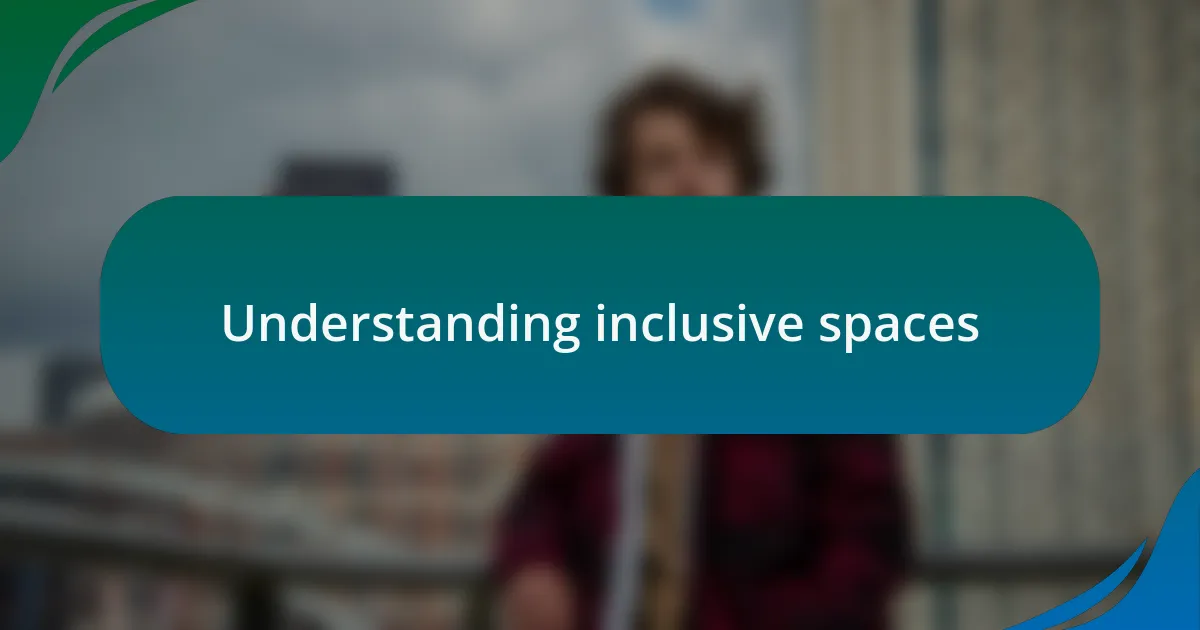
Understanding inclusive spaces
Inclusive spaces are designed to welcome everyone, regardless of age, ability, or background. I remember a park renovation project I was involved in, where we prioritized pathways wide enough for wheelchairs and strollers. It struck me how simple changes, like smooth surfaces and clear signage, can drastically improve accessibility for all.
The importance of inclusive spaces goes beyond mere accessibility; they foster a sense of belonging. I often think back to community meetings where individuals shared heartfelt stories of feeling excluded from public areas. Their accounts ignited a passion in me to advocate for designs that promote interaction and connection, enabling people from diverse backgrounds to mingle and share experiences.
Moreover, the power of inclusive spaces lies in their ability to challenge societal norms. What if our public areas reflected the diversity of our communities? I’ve seen how incorporating elements like gender-neutral restrooms or sensory-friendly zones can transform a space, making it not only functional but also a true representation of our varied identities. This inclusive approach is essential for creating environments that resonate with everyone, encouraging a deeper sense of community and understanding.
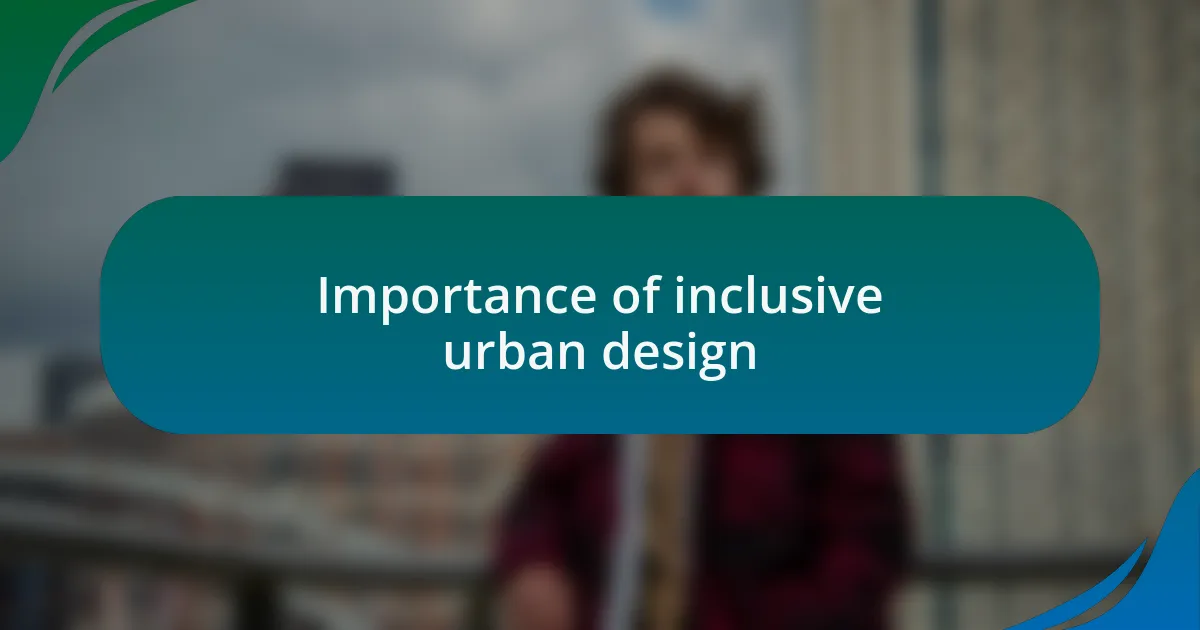
Importance of inclusive urban design
Inclusive urban design is essential because it recognizes and values the uniqueness of every individual. I vividly recall a community workshop where I witnessed elderly residents express their frustration over the lack of seating in public parks. It’s a reminder that when we consider the needs of all demographics, we not only enhance accessibility but also enrich the everyday experiences of our urban environments.
Creating inclusive spaces does more than just accommodate; it inspires interaction and cultural exchange. During a project focused on redesigning a local plaza, I collaborated with artists to incorporate community-driven murals that reflected the diverse stories of our residents. Seeing people gather there, sharing laughter and conversation, was a powerful testament to how thoughtful design can spark connection among strangers.
Inclusive urban design fosters safety and comfort for all users. I once visited a neighborhood that transformed a neglected alley into a vibrant community walkway, featuring colorful lights and relaxing spots. It made me ponder: what if every city prioritized such transformations? The sense of belonging experienced in these spaces can lead to stronger, more resilient communities, ultimately bridging gaps between diverse populations.
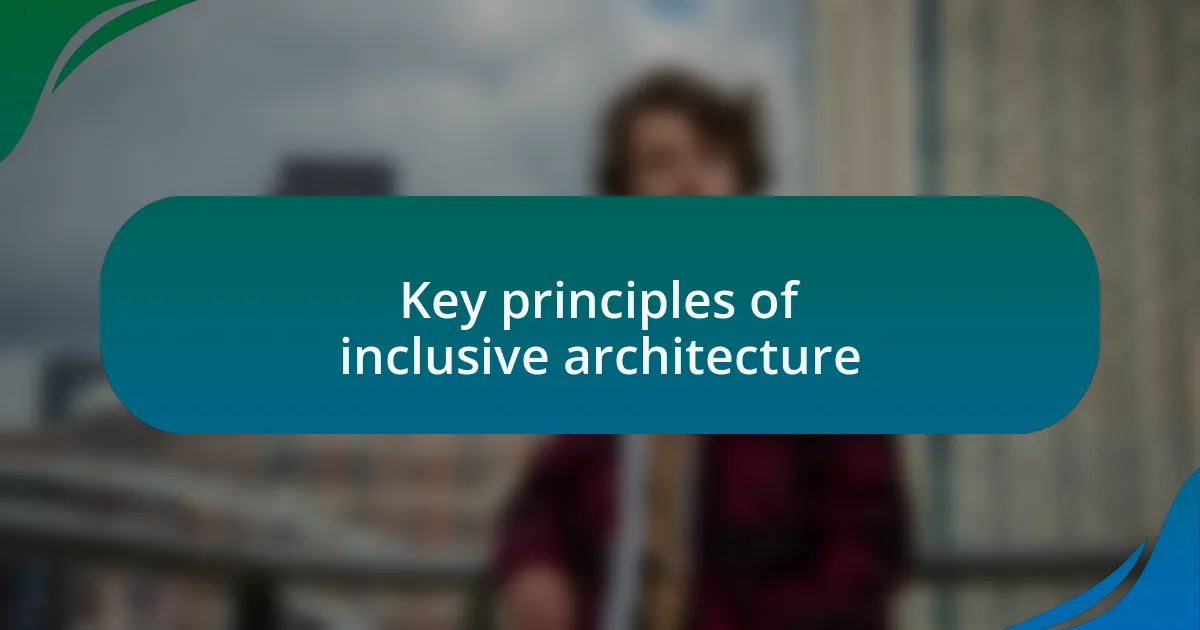
Key principles of inclusive architecture
One fundamental principle of inclusive architecture is accessibility, which goes beyond mere compliance with building codes. I remember visiting a new transit station designed with ramps and tactile paving specifically for individuals with disabilities. Walking through, I felt the pride of the community reflected in those thoughtful choices, making me wonder: how can we ensure that every new structure embodies this principle?
Another key element is flexibility in design. I once worked on a project that involved repurposing an old community center, and we implemented movable walls and multifunctional spaces. It was incredible to witness how a simple change could allow the space to accommodate both a senior yoga class in the morning and a vibrant youth gathering in the evening. It made me realize that by designing adaptable environments, we’re not just meeting current needs, but also anticipating future ones.
Community engagement is also vital in creating inclusive spaces. During a public consultation for a park redesign, I invited residents to share their visions and experiences. Their stories, filled with hopes and challenges, shaped our design process profoundly. Reflecting on that experience, I found myself asking: how can we better involve communities in all stages of development? Their voices have the power to influence and enrich urban landscapes in ways we often overlook.
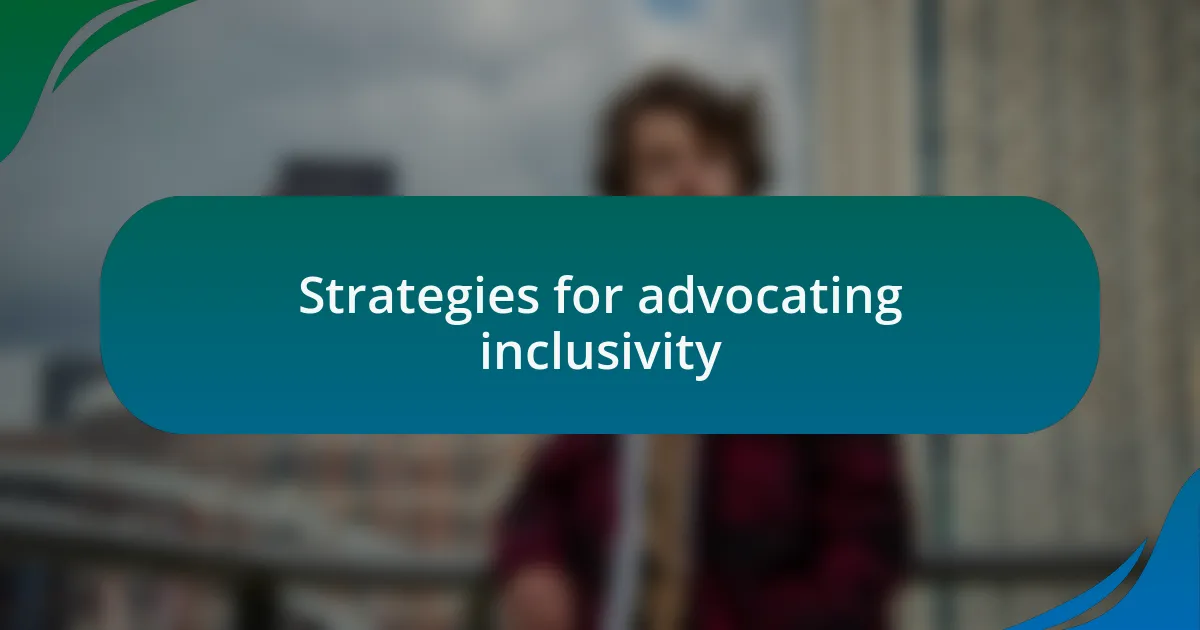
Strategies for advocating inclusivity
When advocating for inclusivity, one effective strategy I’ve found is leveraging grassroots campaigns. I remember organizing a local forum to discuss accessibility needs in our neighborhood. The energy in the room was palpable as people shared their lived experiences, reminding me that each voice matters. How often do we truly listen to those who are affected by our designs? This approach not only brings awareness but also creates a sense of community ownership in the planning process.
Collaborating with diverse stakeholders is another critical strategy. In one project, I worked alongside architects, city planners, and representatives from various social groups. This collaboration opened my eyes to perspectives I had never considered before. It made me ask myself: how can we create spaces that resonate with all community members? By actively engaging with different voices, we can develop designs that genuinely reflect the needs of our urban populations.
Lastly, I believe in the power of education to drive change. While leading workshops on inclusive design, I would share real-life examples of successful projects and the impact they had on the community. Seeing participants’ enthusiasm to implement these concepts was invigorating. It left me wondering: how can we inspire future architects to prioritize inclusivity in every design decision? Educating others not only spreads awareness but also fosters a more inclusive mindset in future urban development.

Personal advocacy experiences
One experience that stands out for me happened during a community design charrette focused on a local park redevelopment. I noticed how many parents with strollers felt excluded from certain areas because of uneven pathways. I asked, “What barriers keep you from enjoying this space fully?” Their candid responses left an impression on me, reinforcing the importance of listening to those most affected by our urban environments. It became clear that real advocacy starts with understanding the everyday challenges people face.
In another instance, while working on a housing project, I engaged directly with residents from diverse backgrounds. One elderly gentleman, who had lived in the neighborhood for over fifty years, shared his memories of communal spaces that used to foster connection. Listening to his stories made me realize how vital it is to design places that not only serve current needs but also honor the past. I found myself reflecting on the question: how can we bridge the gap between memory and modernity in our designs?
I also remember a time when I volunteered at an inclusive arts festival. Watching artists with disabilities showcase their work was a transformative experience. It made me ponder the importance of representation in every aspect of urban design. How often do we consider accessibility not just as a requirement, but as an opportunity for creativity? Engaging with these artists taught me that inclusive spaces aren’t just about meeting standards; they’re about celebrating the richness that diversity brings.
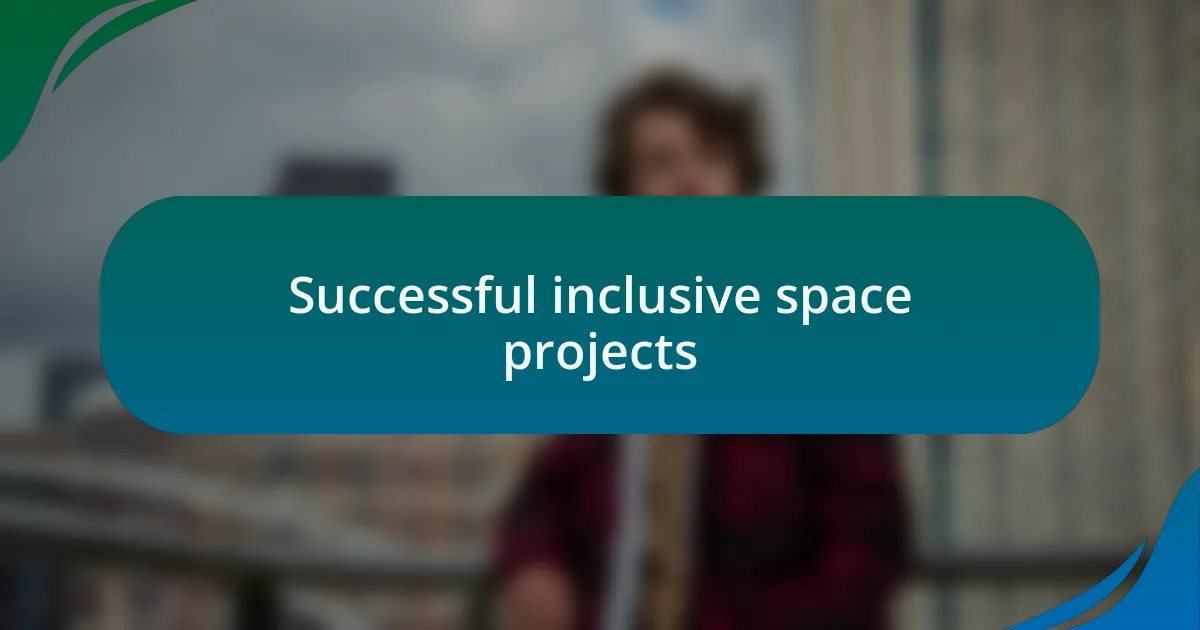
Successful inclusive space projects
Successful inclusive space projects highlight the power of collaboration and community input. For instance, I recall a project in a bustling urban area where local stakeholders were invited to co-create a community garden. The result was not just a beautiful green space, but also a thriving hub where people from various backgrounds connected over gardening workshops and cultural events. It made me wonder, how often do we underestimate the potential of nature to bring people together?
Another noteworthy initiative was an adaptive playground designed specifically for children with different abilities. I visited this playground and could see the joy on children’s faces as they explored equipment created with their needs in mind. The sound of laughter filled the air, prompting me to think: isn’t it incredible how design can empower individuals and foster a sense of belonging? This project became a model for future developments, emphasizing that inclusive design is not merely an addition but an essential part of creating vibrant urban environments.
One project that particularly struck me was the redesign of a city square to facilitate social interaction among various age groups. I remember seeing seniors sitting on benches, families enjoying picnics, and teenagers skateboarding—all within the same space. It was a testament to how thoughtful design can cater to diverse needs. This experience led me to question: how can we ensure that every public space cultivates a sense of community without excluding any demographic? The answer lies in continuous dialogue and an unwavering commitment to inclusivity.
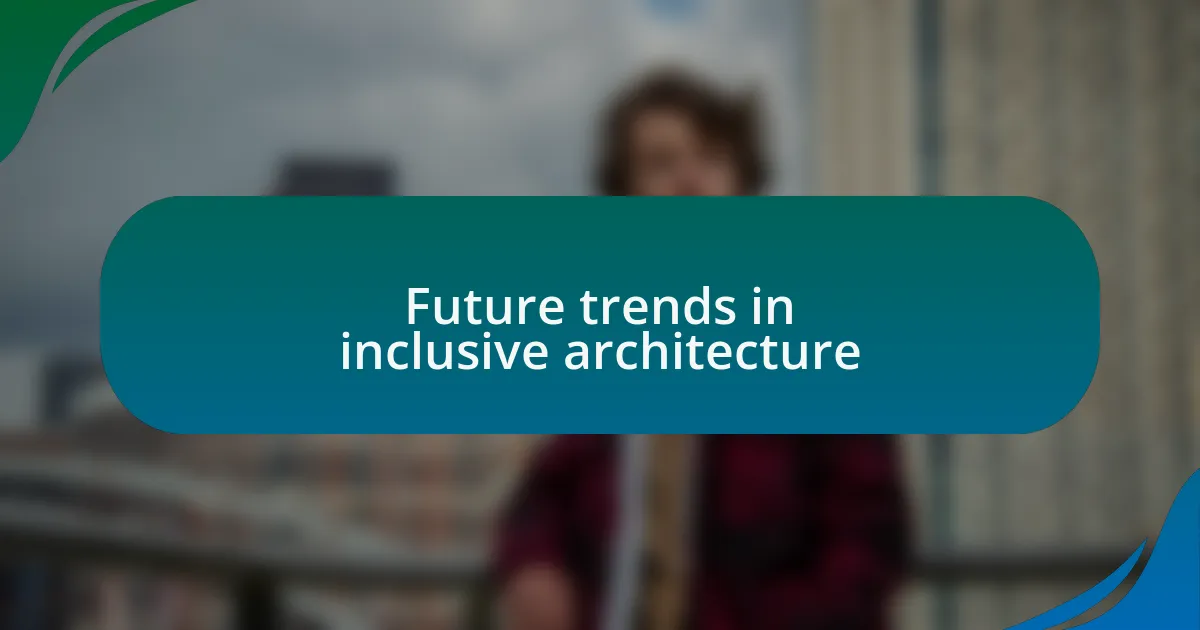
Future trends in inclusive architecture
The future of inclusive architecture is increasingly leaning towards smart technology integration. Imagine walking into a public building equipped with sensors that adjust lighting and temperature based on the needs of its occupants. During a recent workshop, I heard a designer discuss a project incorporating user-responsive elements, which got me thinking: how can we ensure that technology enhances accessibility rather than complicating it? Striking this balance will be crucial as we move forward.
Another emerging trend is biophilic design, which emphasizes our connection to nature. I remember visiting a newly constructed office space that featured abundant natural light, greenery, and open-air designs. It struck me how these elements not only improved aesthetics but also mental well-being. It raises the question: can bringing nature into our built environments further enhance inclusivity by catering to diverse sensory needs? This approach will likely resonate deeply as we consider how to create spaces that nurture, rather than constrain.
Finally, community engagement in the design process is becoming more paramount than ever. I recently attended a town hall meeting where residents contributed ideas for a new community center. The energy in the room was palpable as people from different backgrounds shared their visions for a communal space. It made me reflect on the power of collective input—how can architectural firms genuinely involve future users in their projects? I believe that fostering this collaborative spirit will yield inclusive designs that truly reflect the communities they serve.